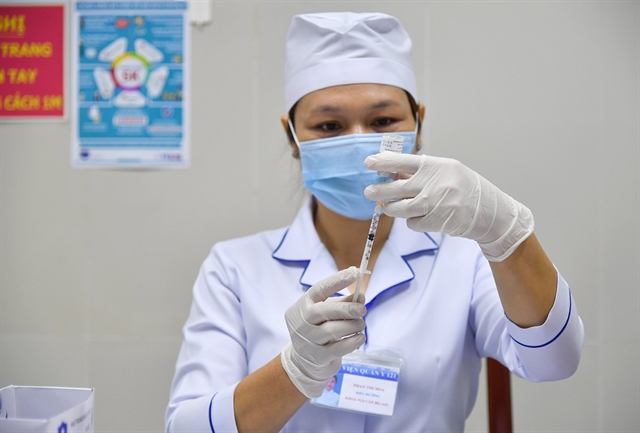 Society
Society


|
| A nurse at the Military Hospital 121 in the southern province of Cần Thơ prepares COVID-19 vaccine jab for frontline military units. — VNA/VNS Photo |
HÀ NỘI — More than 59,000 Vietnamese people have been vaccinated against COVID-19 so far.
The Ministry of Health said that by 4pm on April 12, the 59,249 vaccinated people included frontline doctors, medical staff, sample collectors, contact tracers, members of community-based anti-COVID-19 groups as well as members of the Steering Committee for COVID-19 Prevention and Control of localities.
Nine provinces in the country have completed first-phase vaccination - Tây Ninh, Long An, Bà Rịa-Vũng Tàu, Khánh Hoà, Đà Nẵng, Gia Lai, Hoà Bình, Hà Giang, and Bắc Ninh - using doses in the batch of 117,000 bought from AstraZeneca that arrived in February.
The ministry also said the National Expanded Programme on Immunisation had also been making preparations to distribute 811,200 doses of AstraZeneca from COVAX Facility that were delivered to Việt Nam on April 1 as the second phase of the vaccination drive.
The northern province of Bắc Ninh was the first locality in the country to start administering the vaccines in the second phase, with 311 people inoculated on April 12.
Hà Nội's health authorities planned to administer the 53,350 doses allocated for the capital city from the COVAX doses within April or early May at the latest.
Việt Nam is one of 190 countries participating in the COVAX Facility and is one of the countries belonging to the list to receive sponsored vaccines from the facility.
According to the announcement of COVAX, Việt Nam will receive between 4.8 million and 8.2 million doses, of which 25 – 35 per cent will be provided in the first quarter and 65-75 per cent in the second quarter of this year. The vaccine, provided in this batch, is from AstraZeneca.
The COVAX Facility is a mechanism designed to ensure that countries have equal access to COVID 19 vaccines.
The World Health Organisation (WHO) works with the Global Alliance for Vaccines and Immunisation (GAVI), the United Nations International Children's Emergency Fund (UNICEF), the Coalition for Epidemic Preparedness Innovations (CEPI), vaccine manufacturers and partners to ensure countries have equitable and effective access to vaccines. COVAX will ensure that countries participating in this mechanism have access to vaccines with coverage of about 20 per cent of their population by 2021.
Normal reactions
Relating to AstraZeneca-vaccine injection in Việt Nam, the ministry said about 33 per cent of vaccinated people showed mild reactions, including redness around the injection site, fatigue, slight fever, headache and nausea.
Their health improved within a day or two after the injection and the vaccinated person did not need any treatment, the ministry added.
They were common reactions of not only the COVID-19 vaccine but also other vaccines to prevent infectious diseases such as measles, whooping cough and tetanus, the ministry said.
The ministry also recorded about 0.1 per cent of cases of hypersensitivity reactions after injection. The vaccinated people's health got stable and they could return to work after treatment at medical facilities.
The data on the reaction of AstraZeneca's COVID-19 vaccination in Việt Nam over the past month was similar to the figures provided by the manufacturer, the ministry said.
Việt Nam had yet to record any cases of blood clots and thrombosis occurring after vaccination, the ministry said.
The ministry said the process of vaccination against COVID-19 in Việt Nam always gave the safety of vaccinated people the top priority.
The COVID-19 vaccination facilities were ordered to ensure equipment and human resources and conduct pre-vaccination screening and counselling before injection under the guidance of the ministry.
Vaccinated people must stay at the facilities for at least 30 minutes after vaccination for monitoring. They would be instructed to continue monitoring their health at home for at least 24 hours after injection, the ministry said.
The first aid to prevent severe reactions after vaccination was always available at the vaccination facilities to ensure maximum safety for the vaccinated people, the ministry said.
Vaccination information of the vaccinated person was constantly updated, fully archived, systematically recorded in the electronic health record software to serve vaccine passport. — VNS




